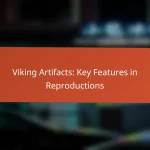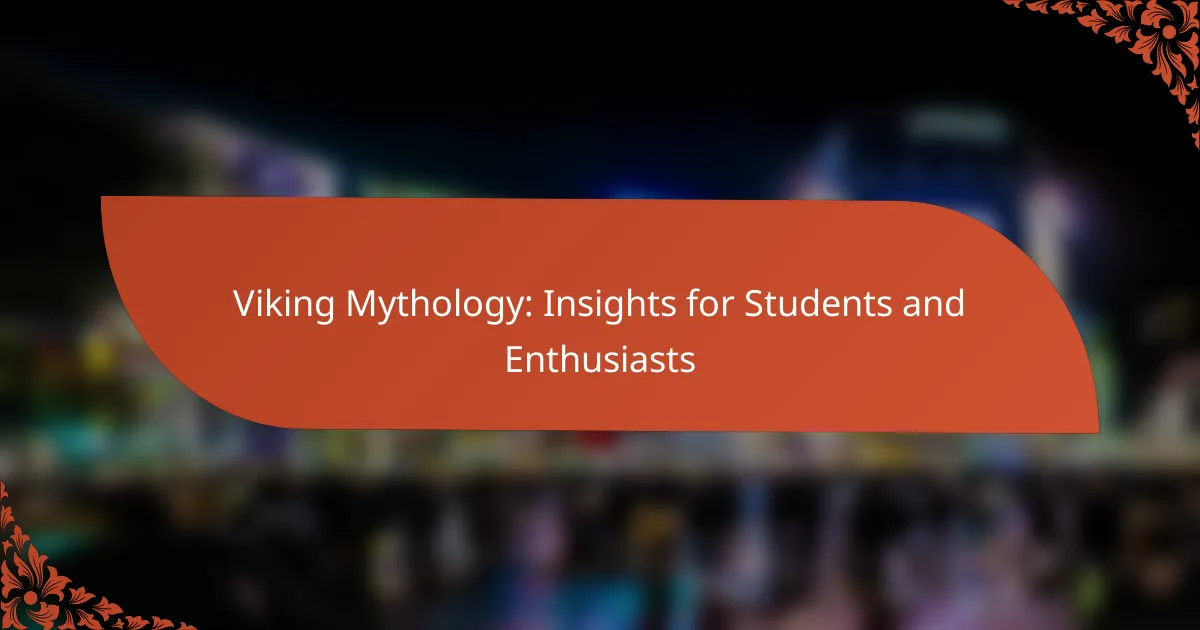Viking mythology continues to resonate in today’s spiritual practices, as many individuals seek to connect with ancient Norse traditions through rituals and symbols. The deities of this rich mythology, such as Odin, Freyja, and Thor, play pivotal roles in shaping contemporary beliefs and fostering a sense of community among practitioners. By integrating these elements, modern spirituality often reflects a deep appreciation for nature and ancestral heritage.

How is Viking mythology practiced in modern spirituality?
Viking mythology is practiced in modern spirituality through various rituals, symbols, and beliefs that connect practitioners to ancient Norse traditions. Many individuals and groups incorporate these elements into their spiritual practices, fostering a sense of community and connection to their heritage.
Rituals and ceremonies
Modern practitioners often engage in rituals and ceremonies that honor the Norse gods, such as Odin, Thor, and Freyja. These may include seasonal celebrations like Yule, which marks the winter solstice, and Blóts, sacrificial feasts to give thanks to the deities. Participants often gather in circles, share offerings, and recite prayers or invocations.
Additionally, some ceremonies involve personal rites of passage, such as naming ceremonies for children or handfasting for couples. These rituals aim to create a sacred space and invite the presence of the gods into the lives of the participants.
Use of runes and symbols
Runes play a significant role in modern Viking spirituality, serving as both a writing system and a means of divination. Practitioners may use rune stones or bindrunes, which are combinations of runes, to create talismans for protection or guidance. Each rune carries specific meanings and energies, allowing individuals to connect with their intentions.
Symbols like the Valknut, a three-cornered knot, and Mjölnir, Thor’s hammer, are also commonly used in spiritual practices. These symbols often represent strength, protection, and the interconnectedness of life and death, making them powerful tools for meditation and focus.
Influence on neo-paganism
Viking mythology has significantly influenced neo-pagan movements, particularly Ásatrú, which seeks to revive ancient Norse beliefs and practices. This spiritual path emphasizes the worship of the Aesir and Vanir gods, nature reverence, and ancestral veneration. Many neo-pagans incorporate elements of Viking mythology into their rituals, creating a blend of old and new practices.
Furthermore, the resurgence of interest in Viking culture has led to the establishment of various groups and organizations that promote education and community engagement around these traditions. This revival encourages individuals to explore their spiritual paths while honoring the rich heritage of Viking mythology.

What are the key deities in Viking mythology?
The key deities in Viking mythology include Odin, Freyja, Thor, and Loki, each representing different aspects of life and nature. These gods and goddesses play significant roles in the spiritual practices of modern practitioners, influencing rituals and beliefs today.
Odin’s role in spiritual practices
Odin, the Allfather, is central to many spiritual practices, embodying wisdom, war, and poetry. Practitioners often seek his guidance through rituals that involve meditation, offerings, or the use of runes, which are believed to carry his wisdom.
To connect with Odin, individuals might create an altar featuring symbols associated with him, such as ravens or spears. Invoking his name during meditation or prayer can enhance the spiritual experience, fostering a deeper understanding of personal journeys and challenges.
Freyja’s significance in modern rituals
Freyja, the goddess of love, fertility, and war, holds a prominent place in contemporary rituals focused on personal growth and relationships. Many practitioners honor her through ceremonies that celebrate love, abundance, and the cycles of nature.
To incorporate Freyja into rituals, individuals may use flowers, crystals, or specific herbs associated with her, such as roses or lavender. Creating a space for offerings and expressing gratitude can help strengthen the connection, inviting her blessings into daily life.
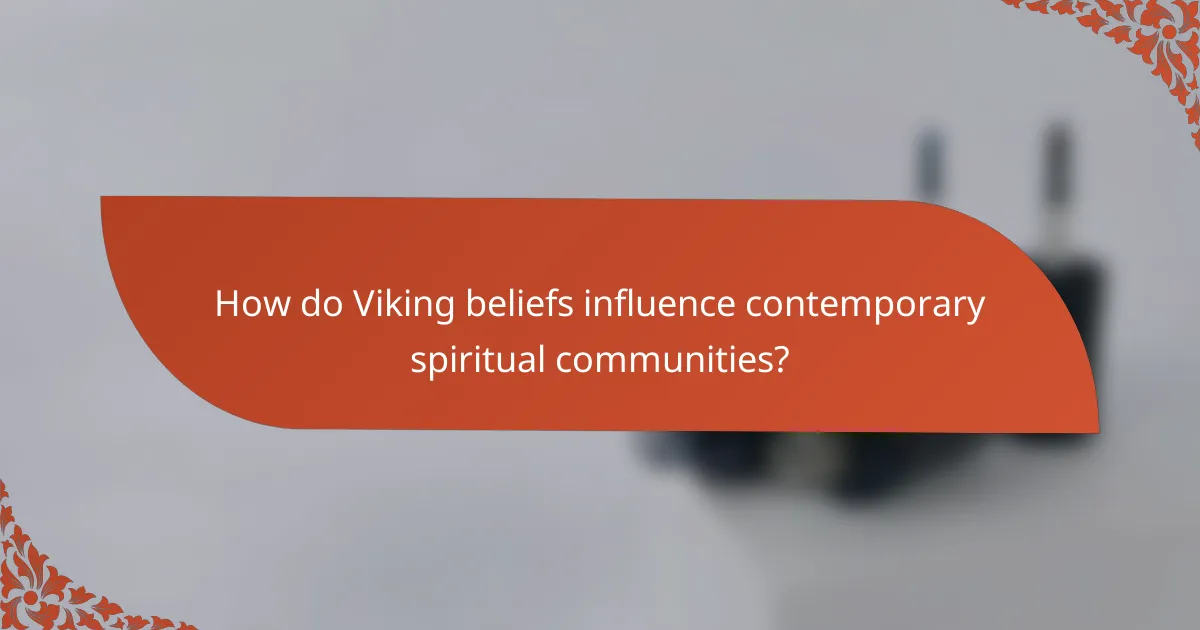
How do Viking beliefs influence contemporary spiritual communities?
Viking beliefs significantly shape modern spiritual practices, particularly among those seeking a connection to nature and ancestral traditions. Many contemporary spiritual communities draw inspiration from Norse mythology, integrating its symbols, deities, and rituals into their practices.
Integration in Wicca
Wicca often incorporates elements of Viking beliefs, particularly through the reverence of nature and the cycles of the seasons. Practitioners may honor Norse deities such as Freyja or Odin during rituals, celebrating their attributes and stories. This integration allows Wiccans to connect with a broader pantheon and enrich their spiritual experiences.
Additionally, the use of runes, which have roots in Norse culture, is common in Wiccan practices. These symbols serve as tools for divination and meditation, helping practitioners gain insight and guidance from the spiritual realm.
Viking-inspired festivals
Viking-inspired festivals celebrate Norse mythology and culture, bringing together communities to honor ancient traditions. Events like Yule, which marks the winter solstice, often feature feasting, storytelling, and rituals that pay homage to gods and goddesses. These gatherings foster a sense of community and shared heritage.
Another notable festival is Blóts, a sacrificial feast held to honor deities and spirits. Participants may offer food, drink, or other items, creating a bond with the divine and the natural world. Such festivals not only revive ancient practices but also promote a deeper understanding of Viking spirituality in today’s context.
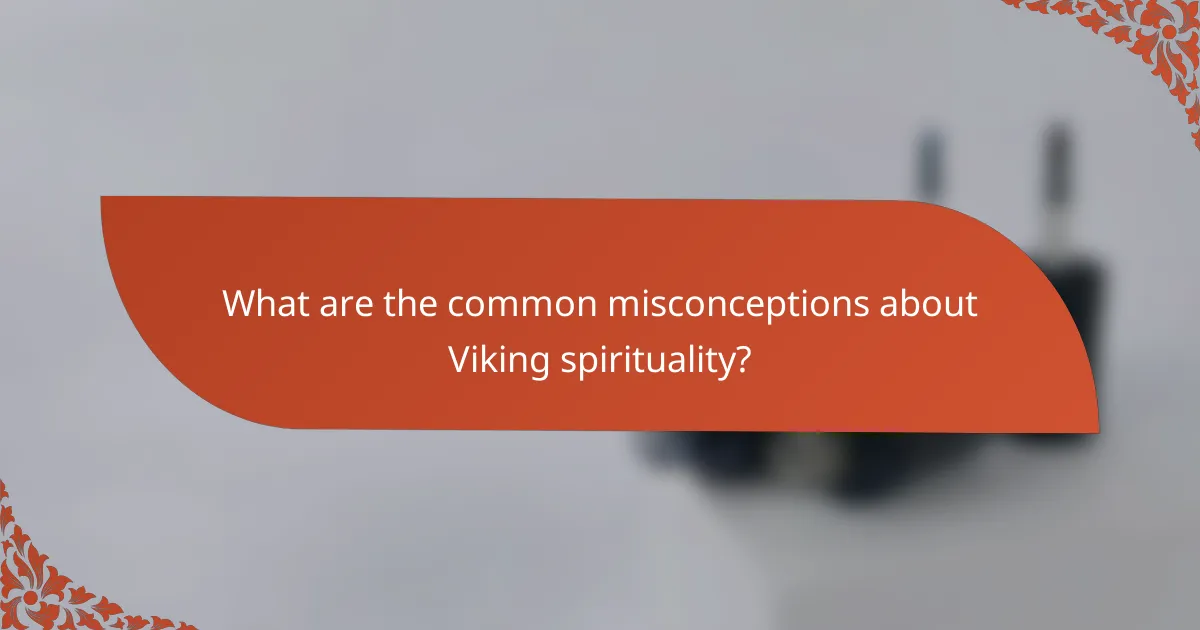
What are the common misconceptions about Viking spirituality?
Many misconceptions about Viking spirituality stem from a blend of popular culture and historical inaccuracies. Often, these misunderstandings simplify complex beliefs and practices, leading to a distorted view of Norse traditions.
Misinterpretations of Norse gods
One common misinterpretation is viewing Norse gods as mere characters in stories rather than as central figures in a rich spiritual framework. Each deity, such as Odin or Thor, represents various aspects of life, nature, and human experience, embodying values and lessons rather than just myths. This perspective can lead to a superficial understanding of their significance in Viking culture.
Additionally, the portrayal of gods in modern media often emphasizes their warrior aspects, overshadowing their roles as symbols of wisdom, fertility, and community. Recognizing the multifaceted nature of these deities is crucial for a deeper appreciation of Viking spirituality.
Distinction between mythology and history
Another misconception lies in conflating Norse mythology with historical fact. While Viking myths provide insights into their worldview, they are not historical accounts. Myths served to explain natural phenomena and human experiences, while historical records focus on actual events and people.
Understanding this distinction is essential for those exploring Viking spirituality today. Engaging with both the mythological narratives and the historical context allows for a more nuanced understanding of how these beliefs influenced Viking life and continue to resonate in modern spiritual practices.

How can one incorporate Viking mythology into personal practices?
Incorporating Viking mythology into personal practices can enhance spiritual connections and provide guidance in daily life. This can be achieved through rituals, affirmations, and creating sacred spaces that reflect Norse beliefs and values.
Daily affirmations inspired by Norse wisdom
Daily affirmations rooted in Norse wisdom can help reinforce positive beliefs and intentions. Phrases inspired by Viking values, such as strength, courage, and resilience, can be recited each morning to set a powerful tone for the day.
Examples of affirmations include: “I embody the strength of Thor,” or “I embrace the wisdom of Odin.” These statements can be tailored to personal goals and aspirations, making them more impactful.
Creating a personal altar
Creating a personal altar can serve as a focal point for spiritual practices inspired by Viking mythology. This space can be adorned with symbols such as runes, images of gods, or natural elements like stones and wood, reflecting the connection to nature that was central to Norse beliefs.
When setting up an altar, consider dedicating it to a specific deity or aspect of Viking culture that resonates with you. Regularly engaging with this space through offerings or meditation can deepen your spiritual experience and connection to Norse traditions.
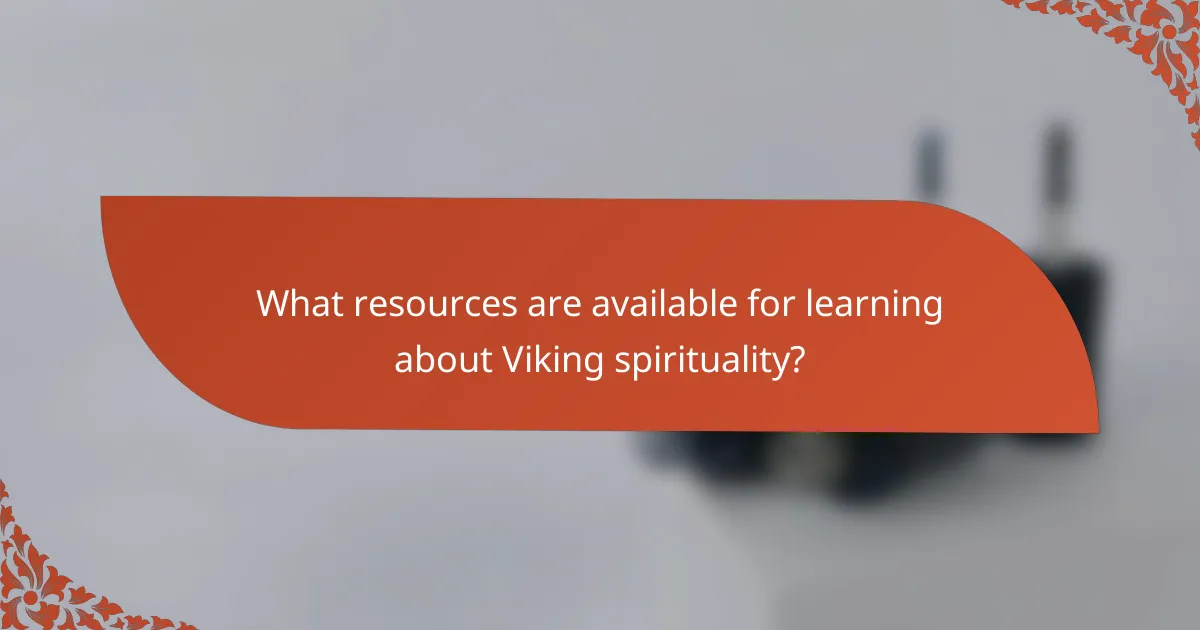
What resources are available for learning about Viking spirituality?
To explore Viking spirituality, various resources can enhance your understanding of Norse mythology and its practices. Key materials include books, online communities, and forums where enthusiasts share insights and experiences.
Books on Norse mythology
Books are a foundational resource for learning about Norse mythology and Viking spirituality. Titles such as “Norse Mythology” by Neil Gaiman and “The Prose Edda” by Snorri Sturluson provide rich narratives and insights into the beliefs and practices of the Vikings. Look for both scholarly texts and accessible retellings to suit your learning style.
When selecting books, consider those that offer commentary or analysis alongside the original myths. This can deepen your understanding of the cultural context and significance of the stories. Aim for a mix of historical accounts and modern interpretations to get a well-rounded perspective.
Online communities and forums
Online communities and forums are excellent platforms for engaging with others interested in Viking spirituality. Websites like Reddit and specialized forums allow users to ask questions, share resources, and discuss various aspects of Norse beliefs. Participating in these communities can provide practical insights and personal experiences that enrich your learning.
When joining online discussions, be respectful and open-minded. Many members may have different interpretations or practices related to Viking spirituality. Engaging with diverse viewpoints can enhance your understanding and help you find your own path within this rich tradition.
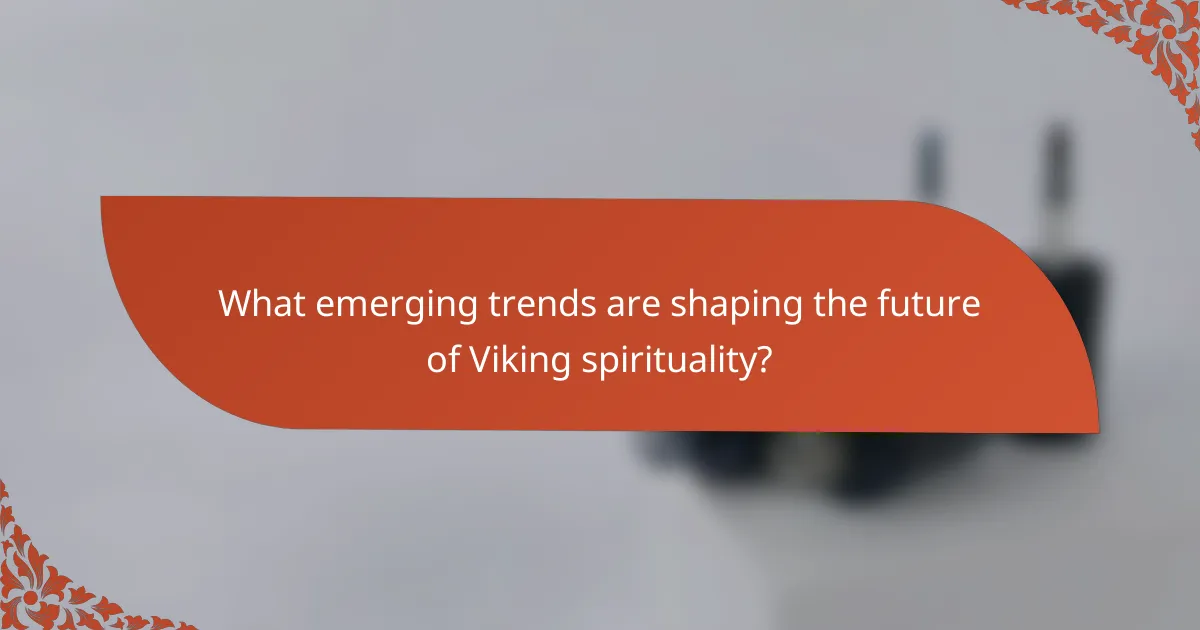
What emerging trends are shaping the future of Viking spirituality?
Emerging trends in Viking spirituality reflect a growing interest in Norse mythology and its practices, particularly among those seeking alternative spiritual paths. This resurgence is characterized by a blend of historical reverence and modern adaptation, appealing to a diverse audience.
Integration of Norse Mythology in Modern Rituals
Many practitioners are incorporating elements of Norse mythology into contemporary rituals, such as seasonal celebrations and personal ceremonies. These rituals often draw on traditional practices, like blóts (sacrificial offerings) and sumbels (ritual toasts), adapted to fit modern contexts.
For example, individuals may celebrate the winter solstice with a feast honoring the gods, invoking blessings for the coming year. This integration allows for a personal connection to ancient beliefs while fostering community among practitioners.
Focus on Nature and Ancestry
A significant trend is the emphasis on nature and ancestral connections within Viking spirituality. Many followers seek to honor the land and their forebears, often engaging in practices that promote environmental stewardship and ancestral veneration.
This can include activities like planting trees in memory of ancestors or participating in local conservation efforts, reinforcing the idea that spiritual practices are intertwined with the natural world and personal heritage.
Online Communities and Resources
The rise of online platforms has facilitated the growth of Viking spirituality by connecting practitioners worldwide. Social media groups, forums, and websites provide resources, discussions, and support for those exploring Norse traditions.
These digital spaces allow for the sharing of experiences, rituals, and interpretations, making it easier for newcomers to learn and engage with Viking spirituality. However, it is essential to approach online information critically, ensuring sources are credible and respectful of the traditions.





